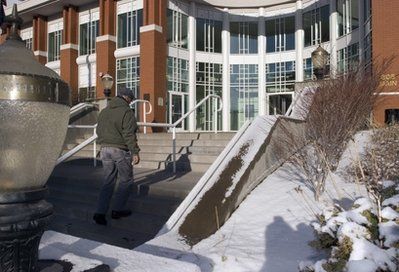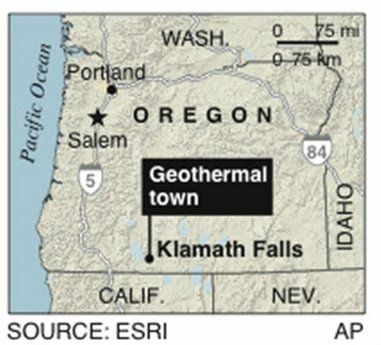
Sidewalks and more are heated by underground hot water
Oregon town uses geothermal energy to stay warm
By Jeff Barnard, Associated Press Writer – Sat Mar 20, 1:56 pm ET
source
KLAMATH FALLS, Ore. – When snow falls on this downtown of brick buildings and glass storefronts in southern Oregon, it piles up everywhere but the sidewalks. It's the first sign that this timber and ranching town is like few others.
A combination of hot rocks and water like those that created Yellowstone's geysers have been tapped by the city to keep the sidewalks toasty since the early 1990s. They also heat downtown buildings, kettles at a brewhouse, and greenhouses and keep the lights on at a college campus.
Geothermal wells in this town of 20,000 mark one of the nation's most ambitious uses of a green energy resource with a tiny carbon footprint, and could serve as a model for a still-fledgling industry that is gaining steam with $338 million in stimulus funds and more than 100 projects nationwide.
"We didn't know it was green. It just made sense," said City Manager Jeff Ball.
Geothermal energy is unknown in much of the country but accounts for 0.5 percent of the nation's energy production.
It can be seen on a snowy day in a handful of Western towns like Klamath Falls. That's because hot rock is closer to the surface here, and comes with the water needed to bring the energy to the surface. Northern California is home to the world's largest geothermal power complex. The Geysers, 75 miles north of San Francisco, produces enough electricity for 750,000 homes.
With more than 600 geothermal wells heating houses, schools and a hospital as well as turning the turbine on a small power plant, Klamath Falls shows what everyday life could be if stimulus grants and venture capitalists turn geothermal energy from a Western curiosity to a game-changing energy resource.
Until now, geothermal energy has been limited by having to find the three essentials ingredients occurring together in one place naturally: hot rock relatively close to the surface, water, and cracks in the rock that serve as a reservoir.
Those limitations go away if engineers can tame a technology known as EGS, for Enhanced Geothermal Systems.
A 2007 Massachusetts Institute of Technology report estimates that EGS, with support, could be producing 100 gigawatts of electricity — equivalent to 1,000 coal-fired or nuclear power plants — by 2050, and has the potential to generate a large fraction of the nation's energy needs for centuries to come.
"If we are going to try to achieve a transformational change in this country, geothermal should be part of that recipe," said Jefferson Tester, chairman of the committee that produced the report and professor of sustainable energy at Cornell University. "It's not treated that way. It's typically forgotten."
One form of EGS involves drilling thousands of feet down to reach hot rock, pumping water down to fracture the rock to create reservoirs, then sending down water that will come back up another well as hot water or steam that can spin a turbine to generate electricity.
The system can be dropped in practically anywhere that hot rocks are close enough to the surface to make drilling economical.
The major problem with EGS is the potential to create earthquakes.
Pumping water into the ground to open numerous tiny fractures in the rock for a reservoir makes the earth move — what scientists call induced seismicity. Earthquakes stopped an EGS project in the middle of Basel, Switzerland, last year, and an international protocol has been developed for monitoring and mitigating earthquake problems.
As long as the wells are not close to major earthquake faults, "it is not damaging, but very upsetting to the community that lives literally on top of it," said Ernie Majer, a seismologist at Lawrence Berkeley National Laboratory in California, and lead author on the protocol.
Federal funding for geothermal started during the 1970s Arab oil embargo, waned when oil prices subsided, and essentially stopped when Texas oilman George W. Bush entered the White House, Majer said.
With interest growing in energy with a tiny carbon footprint, the Obama administration revived support for geothermal energy. Besides handing out more than $40 million a year from the Department of Energy, it is funding 123 demonstration projects in 38 states with stimulus funds. Projects include home heat pumps, power plants, drilling, rock fracturing, exploration and underground mapping.
"The goal of the department is to try to validate that a source of energy could be produced at an adequate price," said Jacques Beaudry-Losique, deputy assistant secretary for renewable energy. He expects results in two to three years.
The centerpiece is $25 million to AltaRock Energy, Inc., of Seattle and Sausalito, Calif., to demonstrate EGS can produce electricity economically and without producing earthquakes just outside the Newberry Craters National Monument in central Oregon. Investors, Google among them, put in $60 million.
Earthquake concerns were mounting around AltaRock's EGS work at The Geysers when they shut it down over drilling problems, before getting to the point of trying to fracture rocks, AltaRock CEO Don O'Shei said. They are developing a system to monitor quakes at Newberry.
"If EGS becomes economical, it will really be a game-changer," O'Shei said. "Even though it is relatively high risk in terms of the money to develop that kind of technology under the ground ($6 million to $20 million for a well that could prove worthless), it is very important."
People in Klamath Falls don't have to be convinced.
IFA Nurseries, Inc., wouldn't have come to Klamath Falls if there wasn't geothermal energy. The geothermal heat cut greenhouse heating costs by a third compared to natural gas, said Jacqueline Friedman, nursery manager for IFA Nurseries.
The city is stepping beyond heat to electricity, building a geothermal generator like the one at Oregon Institute of Technology with the help of an $816,000 stimulus grant.
Stepping gingerly from the icy street to the dry sidewalk on his way to a bakery for a cinnamon roll, Klamath County Museum Manager said visitors are often curious about the geothermal energy in town, which also heats the museum.
"I've always said the city should adopt a slogan, `City of Warm Sidewalks,'" he joked. "But I've been told we'll get every hobo in America who will be drifting into town."



No comments:
Post a Comment